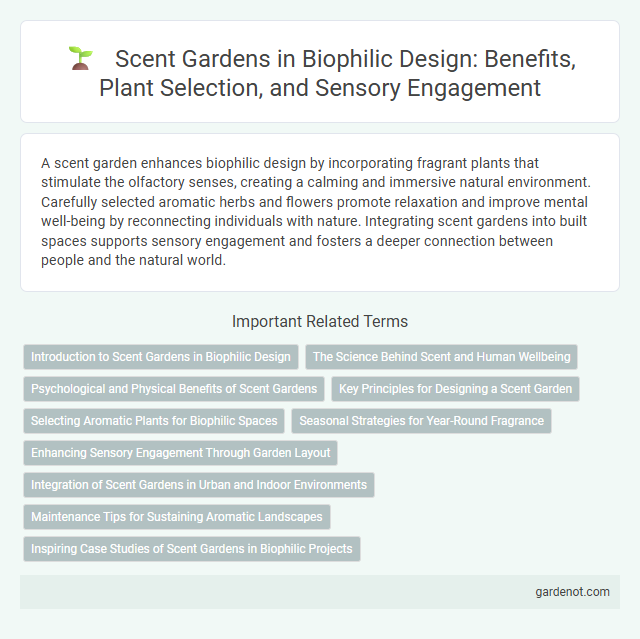A scent garden enhances biophilic design by incorporating fragrant plants that stimulate the olfactory senses, creating a calming and immersive natural environment. Carefully selected aromatic herbs and flowers promote relaxation and improve mental well-being by reconnecting individuals with nature. Integrating scent gardens into built spaces supports sensory engagement and fosters a deeper connection between people and the natural world.
Introduction to Scent Gardens in Biophilic Design
Scent gardens in biophilic design integrate aromatic plants to stimulate sensory engagement and enhance emotional well-being. These gardens utilize natural fragrances like lavender, rosemary, and jasmine to foster calming environments and improve air quality. Incorporating scent gardens into built spaces supports human connection to nature through olfactory experiences that reduce stress and boost cognitive function.
The Science Behind Scent and Human Wellbeing
Scent gardens leverage the connection between specific plant aromas and the brain's limbic system, which regulates emotions and memory, to enhance human wellbeing. Research shows that natural scents such as lavender, rosemary, and jasmine can reduce cortisol levels, lower stress, and improve mood and cognitive function. Incorporating these fragrances into biophilic design maximizes therapeutic benefits by stimulating sensory pathways that promote relaxation and mental clarity.
Psychological and Physical Benefits of Scent Gardens
Scent gardens in biophilic design stimulate the olfactory senses, reducing stress and enhancing mood through natural aromatherapy. Exposure to fragrant plants like lavender or rosemary promotes relaxation, lowers cortisol levels, and improves cognitive function. These gardens also boost physical well-being by encouraging outdoor activity, improving air quality, and supporting immune health.
Key Principles for Designing a Scent Garden
Incorporating diverse aromatic plant species such as lavender, rosemary, and jasmine enhances sensory engagement in a scent garden. Strategic spatial arrangement ensures scent layering and seasonal variation for continuous olfactory stimulation. Integration of accessible pathways and seating areas maximizes user interaction and comfort within the biophilic space.
Selecting Aromatic Plants for Biophilic Spaces
Selecting aromatic plants such as lavender, rosemary, and jasmine enhances biophilic spaces by stimulating the senses and promoting relaxation through natural scents. Incorporating native species that thrive in local climates ensures sustainable growth and maximizes aromatic intensity. Thoughtful placement of these plants near seating areas or walkways creates immersive scent gardens that improve air quality and support mental well-being.
Seasonal Strategies for Year-Round Fragrance
Scent gardens employ seasonal strategies by incorporating a diverse selection of aromatic plants that bloom at different times of the year, ensuring continuous fragrance throughout all seasons. Popular choices include spring-flowering hyacinths and lilacs, summer-blooming jasmine and lavender, autumn-scented chrysanthemums, and winter-hardy rosemary or pine. These botanicals enhance the biophilic design by creating multi-sensory experiences that connect occupants with nature's cyclical rhythms.
Enhancing Sensory Engagement Through Garden Layout
Scent gardens strategically arrange aromatic plants such as lavender, rosemary, and jasmine to optimize sensory engagement by enhancing olfactory stimulation throughout the space. Pathways are designed to guide visitors through contrasting fragrance zones, allowing for a dynamic and immersive experience of diverse scents. Incorporating multi-sensory elements like textured foliage and seasonal blooms further enriches the garden's ability to connect visitors with nature at a profound sensory level.
Integration of Scent Gardens in Urban and Indoor Environments
Scent gardens enhance urban and indoor environments by integrating aromatic plants that improve air quality and promote psychological well-being. Incorporating fragrant species such as lavender, rosemary, and jasmine creates multisensory experiences that reduce stress and increase relaxation in confined spaces. Strategic placement of scent gardens in urban green spaces and office interiors supports biophilic design principles by reconnecting people with nature through olfactory stimuli.
Maintenance Tips for Sustaining Aromatic Landscapes
Regular pruning and deadheading promote healthy growth and prolonged blooming in scent gardens, ensuring continuous fragrance. Applying organic mulch retains soil moisture and suppresses weeds, creating an optimal environment for aromatic plants. Consistent watering schedules tailored to plant species prevent stress, enhancing scent intensity and overall garden vitality.
Inspiring Case Studies of Scent Gardens in Biophilic Projects
Scent gardens in biophilic design projects prominently feature aromatic plants such as lavender, jasmine, and rosemary to enhance sensory engagement and promote well-being. Notable case studies include Singapore's Gardens by the Bay, where fragrant flora create immersive experiences that connect visitors with nature and stimulate memory and relaxation. These projects demonstrate how integrating olfactory elements fosters emotional connections and improves environmental quality in urban spaces.
Scent garden Infographic

 gardenot.com
gardenot.com